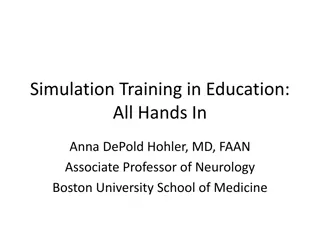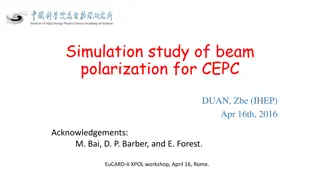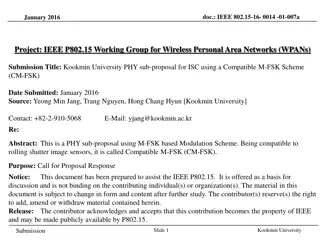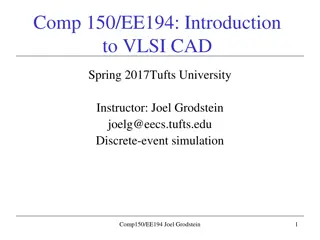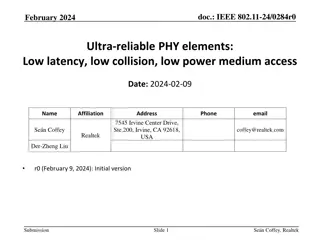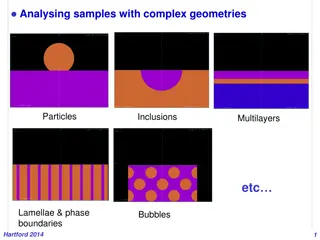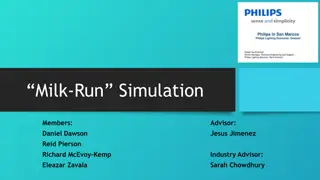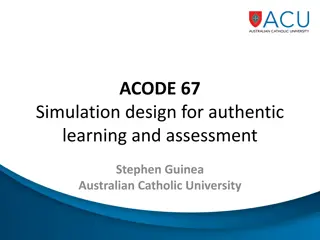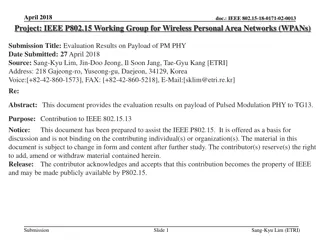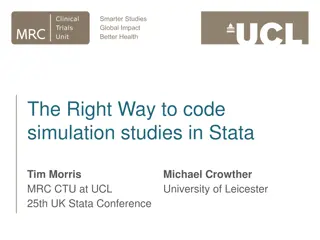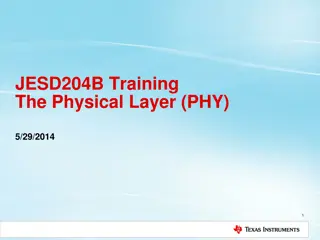Simulation Results for LC-Optimized PHY Proposal in July 2019
The document presents simulation results for an LC-optimized PHY proposal for TGbb based on G.9991 PHY. It includes details on the simulation setup, frame detection results, header modulation, coding simulation results, payload modulation, and coding simulation results. The setup involved various repetitions and configurations for preamble, header, payload, and payload OFDM. The results highlight minimum SNR for detection rate, header parameters such as information bits, bandwidth, FFT size, cyclic prefix length, modulation, FEC code rate, and FEC block size.
Download Presentation

Please find below an Image/Link to download the presentation.
The content on the website is provided AS IS for your information and personal use only. It may not be sold, licensed, or shared on other websites without obtaining consent from the author. Download presentation by click this link. If you encounter any issues during the download, it is possible that the publisher has removed the file from their server.
E N D
Presentation Transcript
July 2019 doc.: IEEE 802.11-19/1054r2 Simulation results for LC-optimized PHY proposal Date: 2019-07-15 Authors: Name Malte Hinrichs Affiliations Fraunhofer HHI email malte.hinrichs@hhi.fraunhofer.de Volker Jungnickel Fraunhofer HHI Salvador Iranzo Molinero Maxlinear Marcos Martinez Vazquez Maxlinear Mate Hinrichs (Fraunhofer HHI) Submission Slide 1
July 2019 doc.: IEEE 802.11-19/1054r2 Abstract The submission presents the simulations regarding the LC-optimized PHY for TGbb based on G.9991 PHY 1 [1]. Mate Hinrichs (Fraunhofer HHI) Submission Slide 2
July 2019 doc.: IEEE 802.11-19/1054r2 Outline 1. Simulation setup 2. Frame detection simulation results 3. Header modulation and coding simulation results 4. Payload modulation and coding simulation results Mate Hinrichs (Fraunhofer HHI) Submission Slide 3
July 2019 doc.: IEEE 802.11-19/1054r2 Simulation setup See doc. 11-19/187r4: - Preamble: 100,000 repetitions, false alarm rate 0,1% - Header: 10,000 repetitions - Payload: 1,000 repetitions - OCR: 200 MHz Signal power is measured at red circle. The SNR is set by adjusting noise power in the following AWGN block accordingly. The impact of the Rx model on SNR is assumed to be neglibible, as the used bandpass cutoff frequencies exceed the signal bandwidth. Mate Hinrichs (Fraunhofer HHI) Submission Slide 4
July 2019 doc.: IEEE 802.11-19/1054r2 Simulation setup (cont.) Payload OFDM setup: - Subcarriers 24..965: 4.6875..188.4765625 MHz - Modulation depths: 1, 6, 12 bits/subcarrier - FEC configuration: block length 4320 bits, code rates 1/2, 5/6, 20/21 Mate Hinrichs (Fraunhofer HHI) Submission Slide 5
July 2019 doc.: IEEE 802.11-19/1054r2 Frame detection simulation results Min. SNR for Detection rate > 0.999 OFE only -6 dB Industrial Wireless D7 -7 dB Enterprise conf. room S1-D1 -6 dB Enterprise conf. room S1-D2 -6 dB Enterprise conf. room S3-D1 -6 dB Enterprise conf. room S3-D2 -6 dB Mate Hinrichs (Fraunhofer HHI) Submission Slide 6
July 2019 doc.: IEEE 802.11-19/1054r2 Header simulation results Header parameters: - Header information: 168 bits - Bandwidth: 200 MHz (used: 183.98 MHz) - FFT size: 1024 (occupied subcarriers: 942) - Cyclic prefix length: 256 - Modulation: QPSK (2 bits/SC) - FEC code rate: 1/2 - FEC block size: 168 bits Mate Hinrichs (Fraunhofer HHI) Submission Slide 7
July 2019 doc.: IEEE 802.11-19/1054r2 Header simulation results ?: bits per symbol,????: symbol rate, ??: sample rate ?? ?0 ?? = SNR + 10log10 ????? Header (200 MHz): ?? = 1280,? = 168 ???? ?? ?0 1280 168 = SNR + 10 log10 = SNR + 8.819 dB Mate Hinrichs (Fraunhofer HHI) Submission Slide 8
July 2019 doc.: IEEE 802.11-19/1054r2 Header simulation results Header parameters: - Header information: 168 bits - Bandwidth: 200 MHz (used: 183.98 MHz) - FFT size: 1024 (occupied subcarriers: 942) - Cyclic prefix length: 256 - Modulation: QPSK (2 bits/SC) - FEC code rate: 1/2 - FEC block size: 168 bits Mate Hinrichs (Fraunhofer HHI) Submission Slide 9
July 2019 doc.: IEEE 802.11-19/1054r2 Payload simulation results Low MCS Payload parameters: - Data length: 4320000 bits - Bandwidth: 200 MHz (used: 183.98 MHz) - FFT size: 1024 (occupied subcarriers: 942) - Cyclic prefix length: 64 - Modulation: BPSK (1 bit/SC) - FEC code rate: 1/2 - FEC block size: 4320 bits Mate Hinrichs (Fraunhofer HHI) Submission Slide 10
July 2019 doc.: IEEE 802.11-19/1054r2 Payload simulation results Low MCS SNR to Eb/N0: ?? = 1088,? = 942 1 1 2= 471 ???? ?? ?0 1088 471= SNR + 3.636 dB = SNR + 10 log10 Throughput (Payload): ? ????= 471 bits 183.824 kHz = 86.58 Mbit/s Mate Hinrichs (Fraunhofer HHI) Submission Slide 11
July 2019 doc.: IEEE 802.11-19/1054r2 Payload simulation results Low MCS Payload parameters: - Data length: 4320000 bits - Bandwidth: 200 MHz (used: 183.98 MHz) - FFT size: 1024 (occupied subcarriers: 942) - Cyclic prefix length: 64 - Modulation: BPSK (1 bit/SC) - FEC code rate: 1/2 - FEC block size: 4320 bits Mate Hinrichs (Fraunhofer HHI) Submission Slide 12
July 2019 doc.: IEEE 802.11-19/1054r2 Payload simulation results Medium MCS Payload parameters: - Data length: 4320000 bits - Bandwidth: 200 MHz (used: 183.98 MHz) - FFT size: 1024 (occupied subcarriers: 942) - Cyclic prefix length: 64 - Modulation: 64-QAM (6 bits/SC) - FEC code rate: 5/6 - FEC block size: 4320 bits Mate Hinrichs (Fraunhofer HHI) Submission Slide 13
July 2019 doc.: IEEE 802.11-19/1054r2 Payload simulation results Medium MCS SNR to Eb/N0: ?? = 1088,? = 942 6 5 6= 4710 ???? ?? ?0 1088 4710= SNR 6.364 dB = SNR + 10 log10 Throughput (Payload): ? ????= 4710 bits 183.824 kHz = 865.81 Mbit/s Mate Hinrichs (Fraunhofer HHI) Submission Slide 14
July 2019 doc.: IEEE 802.11-19/1054r2 Payload simulation results Medium MCS Payload parameters: - Data length: 4320000 bits - Bandwidth: 200 MHz (used: 183.98 MHz) - FFT size: 1024 (occupied subcarriers: 942) - Cyclic prefix length: 64 - Modulation: 64-QAM (6 bits/SC) - FEC code rate: 5/6 - FEC block size: 4320 bits Mate Hinrichs (Fraunhofer HHI) Submission Slide 15
July 2019 doc.: IEEE 802.11-19/1054r2 Payload simulation results High MCS Payload parameters: - Data length: 4320000 bits - Bandwidth: 200 MHz (used: 183.98 MHz) - FFT size: 1024 (occupied subcarriers: 942) - Cyclic prefix length: 64 - Modulation: 4096-QAM (12 bits/SC) - FEC code rate: 20/21 - FEC block size: 4320 bits Mate Hinrichs (Fraunhofer HHI) Submission Slide 16
July 2019 doc.: IEEE 802.11-19/1054r2 Payload simulation results High MCS SNR to Eb/N0: ?? = 1088,? = 942 12 20/21 = 10765.71 ???? ?? ?0 1088 10765.71= SNR 9.954 dB = SNR + 10 log10 Throughput (Payload): ? ????= 10765.71 bits 183.824 kHz = 1.979 Gbit/s Mate Hinrichs (Fraunhofer HHI) Submission Slide 17
July 2019 doc.: IEEE 802.11-19/1054r2 Payload simulation results High MCS Payload parameters: - Data length: 4320000 bits - Bandwidth: 200 MHz (used: 183.98 MHz) - FFT size: 1024 (occupied subcarriers: 942) - Cyclic prefix length: 64 - Modulation: 4096-QAM (12 bits/SC) - FEC code rate: 20/21 - FEC block size: 4320 bits Mate Hinrichs (Fraunhofer HHI) Submission Slide 18









